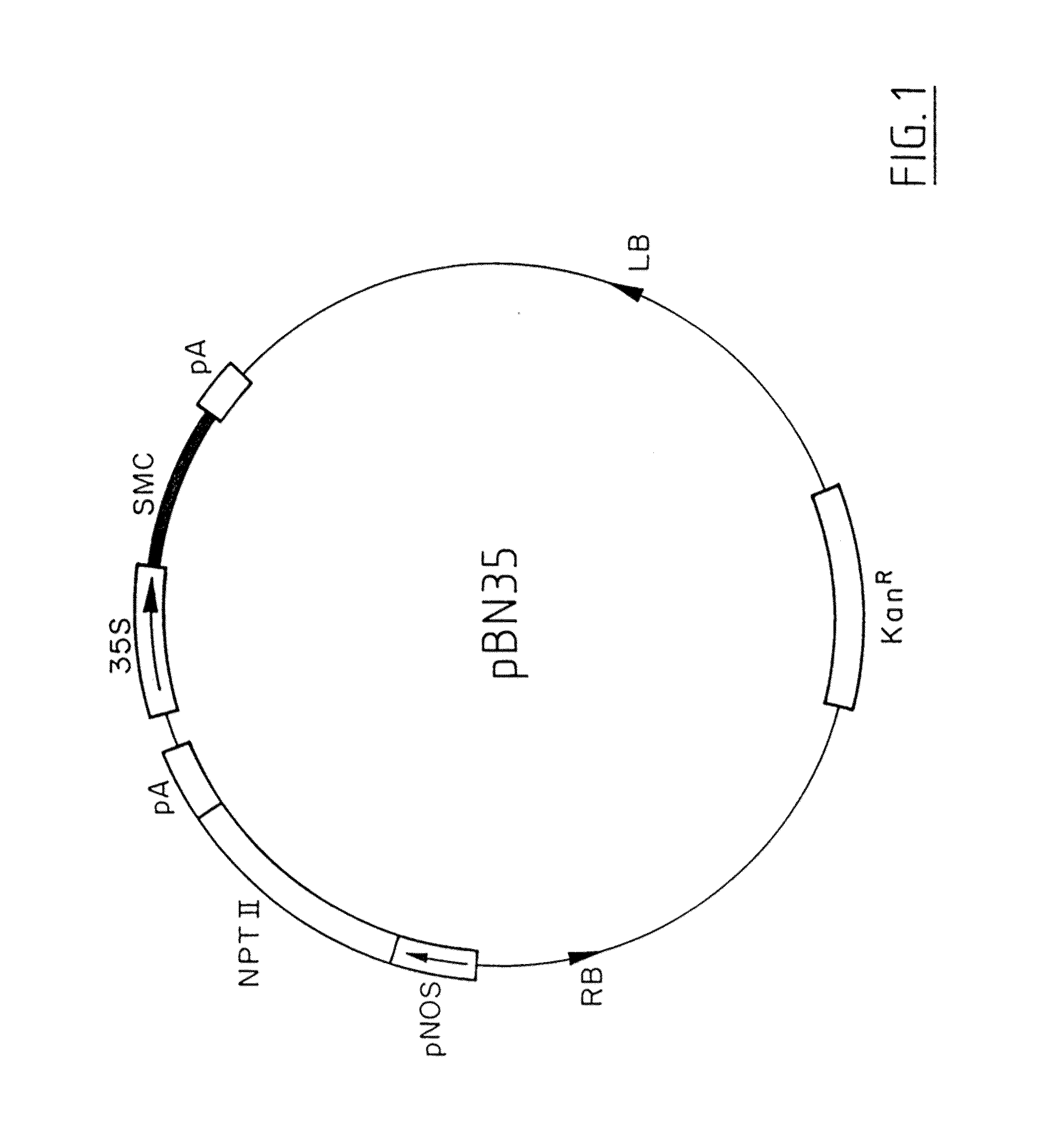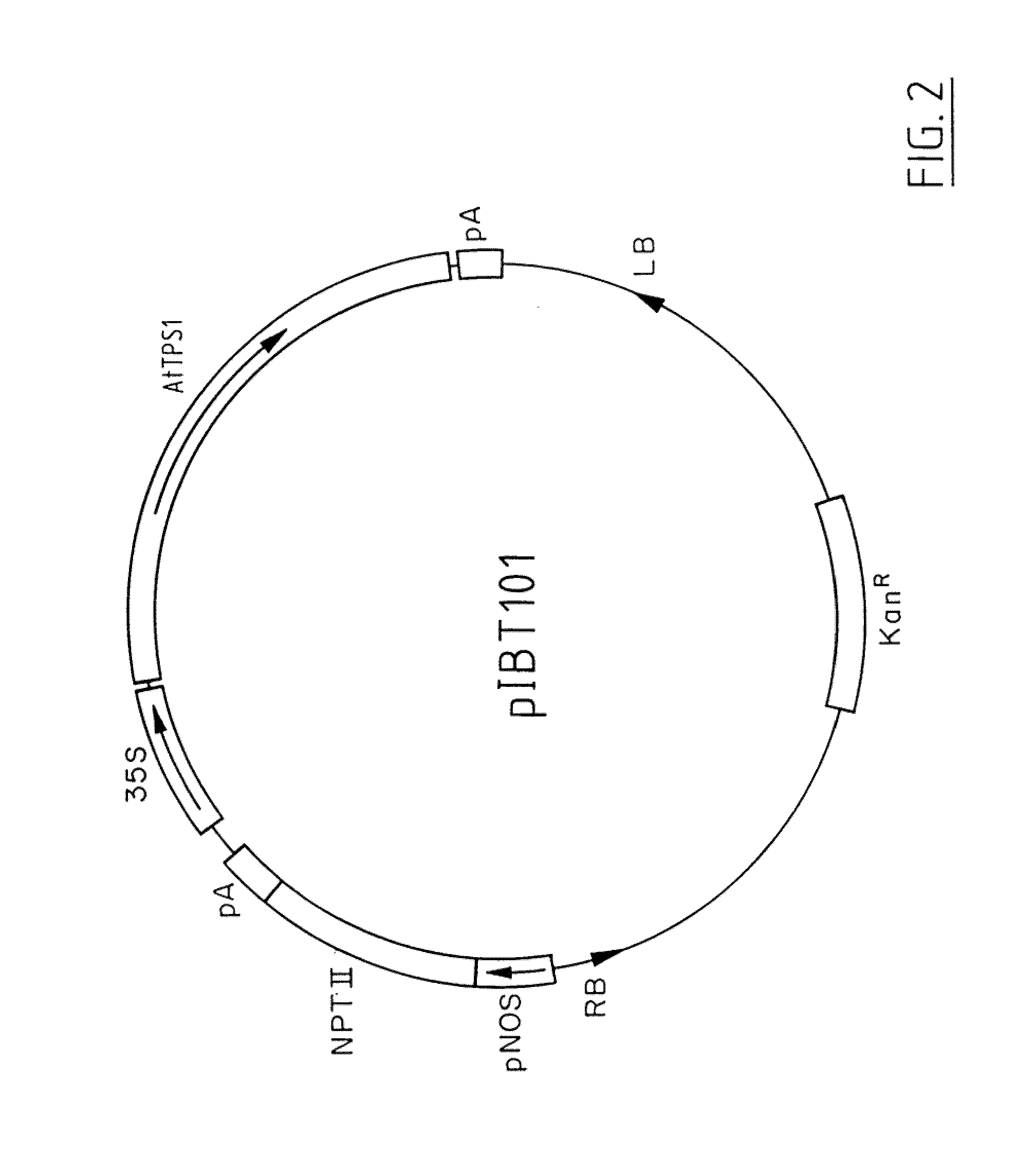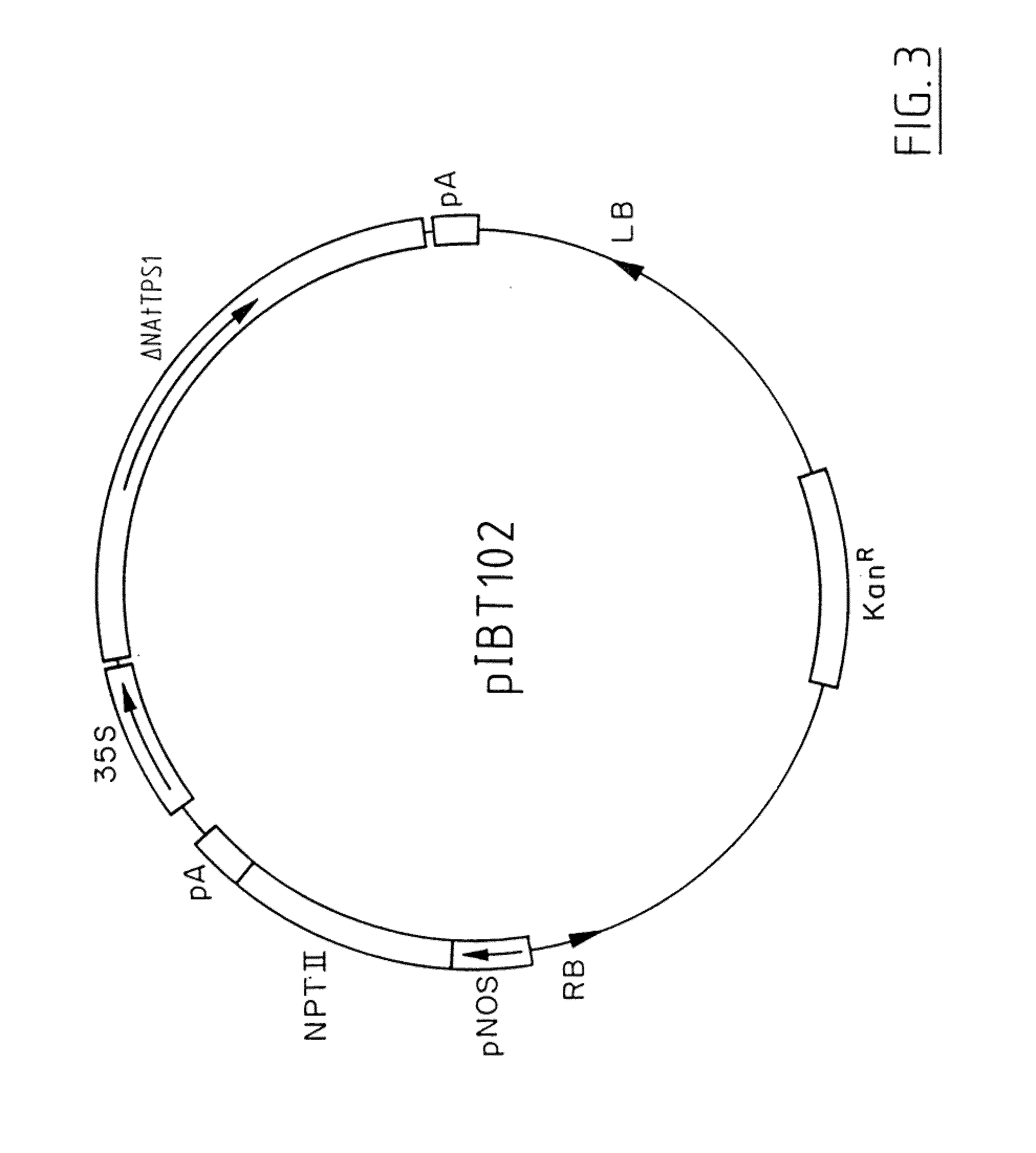Specific genetic modification of the activity of trehalose-6-phosphate synthase and expression in a homologous or heterologous environment
a technology of trehalose-6-phosphate and gene product, which is applied in the direction of enzymology, peptides, transferases, etc., can solve the problems of inability to demonstrate the activity of enzymatic trehalose-6-phosphate synthase of these tps gene products in any in vitro system, and no successful use of these plant or animal tps gene products to improve commercially important properties in homologous or heterolog
- Summary
- Abstract
- Description
- Claims
- Application Information
AI Technical Summary
Benefits of technology
Problems solved by technology
Method used
Image
Examples
example 1
Selection of TPS Genes
[0080]A suitable TPS gene can be selected in various manners. There are two main possibilities to isolate plant TPS genes. First of all, functional complementation of Saccharomyces cerevisiae cells that are deleted for the TPS1 gene is a straightforward approach. Deletion of this gene causes a pleiotropic phenotype in yeast (Van Aelst et al., 1993, Mol. Microbiol. 8, 927-943). One of the phenotypes is that such cells cannot grow on glucose. Construction of cDNA libraries from interesting plants in yeast expression plasmids can be used to transform a yeast strain that is deleted for TPS1. Transformants can than be checked for the restoration of growth on glucose. On the other hand, the synthesis of trehalose in the transformants can also be measured. If transformants are found that restore the growth on glucose medium or that produce again trehalose, the plasmid DNA can be isolated and the inserts sequenced. Based on the sequence it can then be concluded whether...
example 2
Preparation of Constructs
1. Construction of Yeast Expression Vectors Containing Plant TPS Genes.
[0088]A 3.1-kb fragment containing the full length SlTPS1 gene was obtained after amplification by PCR (94° C., 3 min, 1 cycle; 94° C., 1 min, 50° C., 1 min, 72° C., 2 min, 40 cycles; 72° C., 10 min, 1 cycle) using Expand High-fidelity DNA polymerase (Boehringer). As oligonucleotides, SLTPS-S1 (5′-CATGCCATGGCTATGCCTCAGCCTTACC-3′, (SEQ ID NO: 1) bold indicates initiation codon and underlined NcoI site) and universal (5′-GTAAACGACGGCCAGT-3′) (SEQ ID NO: 2) primers were used with S1-TPS1 cDNA cloned in pBluescript SK as template. The PCR-fragment was digested with NcoI and KpnI and cloned in pSAL4. Yeast tps1) and tps1) tps2) mutant strains were transformed and selected on SDGal (-ura) plates. Complementation was assayed in SDG1c (-ura minimal medium plus 100 μM CuSO4).
[0089]For the construction of the N-terminal deletion construct the following oligonucleotides were used:
oligo 5′ SLTPS-100 ...
example 3
Functional Complementation of Yeast Tps Mutants with Modified Plant TPS Genes
[0107]1. Complementation of the Growth Defect of tps1Δ and tps1Δtps2Δ Strains
[0108]Tps1Δ and tps1Δtps2Δ strains were transformed with yeast expression vectors containing either full length or N-terminal deleted S. lepidophylla or A. thaliana TPS genes. As controls, Wild Type, tps1Δ or tps1Δtps2Δ strains were transformed with an empty plasmid, or with a plasmid containing the yeast TPS1 gene. Transformants were tested for growth on glucose and fructose containing medium. FIG. 6 shows the growth on glucose and fructose containing medium of Wild Type and tps1Δ strains transformed with a yeast expression vector containing a complete or the truncated S. lepidophylla TPS gene. The lanes are as follows: 1. WT, 2. tps1Δ, 3. tps1Δ+ANTPS1 S1, 4. tps1Δ+TPS1 S1, 5. tps1Δ+TPS1S, 6. tPS1ΔtPs2Δ, 7. tPS1ΔtPs2Δ+ΔNTPS1 S1, 8. tPs1ΔtPS2Δ+TPS1 S1, 9. tps1Δtps2Δ+TPS1 Sc, 10. tps1Δtps2Δ+TPS2 Sc.
[0109]The full length clone can on...
PUM
| Property | Measurement | Unit |
|---|---|---|
| humidity | aaaaa | aaaaa |
| temperature | aaaaa | aaaaa |
| temperature | aaaaa | aaaaa |
Abstract
Description
Claims
Application Information
 Login to View More
Login to View More - Generate Ideas
- Intellectual Property
- Life Sciences
- Materials
- Tech Scout
- Unparalleled Data Quality
- Higher Quality Content
- 60% Fewer Hallucinations
Browse by: Latest US Patents, China's latest patents, Technical Efficacy Thesaurus, Application Domain, Technology Topic, Popular Technical Reports.
© 2025 PatSnap. All rights reserved.Legal|Privacy policy|Modern Slavery Act Transparency Statement|Sitemap|About US| Contact US: help@patsnap.com



